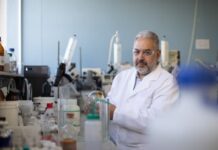
Media Release
Launched today, the Faculty of Engineering’s new School of Biomedical Engineering will aim to “continue the University’s record of real-world problem-solving.”
The University of Sydney today announced the launch of its new School of Biomedical Engineering, investing in the development of advanced biomedical technologies such as lab-grown organs, bionic eyes and implantable medical devices.
Becoming the sixth school within the Faculty of Engineering, the School has been established to facilitate collaborative research and teaching within the field of biomedical engineering, which combines a range of disciplines including medicine, engineering and life sciences.
Joining as the Head of School, Biomedical Engineering, Professor Gregg Suaning, said the Faculty’s focus will facilitate new collaborations, boost Australia’s healthcare sector and place the University in a leading position within the surging global biomedical market.
“Australia is at the forefront of biomedical engineering and it’s essential that we invest in research and technology that will lead us to a new generation of medical therapies and cures,” said Professor Suaning, whose work has focused on developing a bionic eye for those living with blindness.
“The new School’s aim is to improve health outcomes by targeting diseases that currently do not have cures. We will achieve this through innovative biotechnologies focused on tissue and neural engineering, nanomaterials and by introducing novel approaches to overcome chronic disease,” he said.
Included in the School’s arsenal of state-of-the-art infrastructure is the Sydney Bionics Translation Centre, a laboratory which provides cleanroom and prototyping capabilities; the Industrial Transformation Training Centre for Innovative Bioengineering which includes a musculoskeletal tissue engineering laboratory; and a high-energy plasma research laboratory that will be used for therapeutic innovations that involve specialised surfaces.
Within the next two years, the School’s infrastructure will be further enhanced by the new Bio-Engineering Research Hub, a specialised building designed with ‘research ready’ laboratories and capabilities that will equip researchers to tackle pressing medical challenges, such as the diagnosis, treatment and curing of diseases.
Dean of Engineering, Professor Willy Zwaenepoel said the Faculty’s focus on biomedical engineering and investment in custom-built laboratories would facilitate collaborative research.
“Our purpose-built research facilities will help enable the School of Biomedical Engineering to take medical devices from the concept stage through to the clinic and beyond,” said Professor Zwaenepoel.
“Drawing on the combined experience of our world class researchers, the School will offer unparalleled opportunities for those undertaking research in this area,” he said.
University of Sydney Vice-Chancellor and Principal, Dr Michael Spence expects the Faculty’s new focus will further the University’s commitment to developing tangible technology that has a positive impact on society.
“Our engineering researchers are among the best in the world for innovation and ingenuity. From lab-grown organs to bionic eyes, the new School of Biomedical Engineering will continue our record of real-world problem-solving in this discipline, assisting industry and the community alike,” said Dr Spence.
The school will work collaboratively with industry, government and the healthcare sector, as well as across disciplines at the University, including the Faculty of Medicine and Health, the Sydney Nano Institute, the Charles Perkins Centre, the Brain and Mind Centre, and Westmead.
Speaking as the guest of honour at the School’s launch, University of Washington bioengineering academic, Professor Matthew O’Donnell said the University of Sydney was at the forefront of change.
“Biomedical engineering has developed into a core discipline for modern engineering. The University of Sydney has recognised this fact and moved quickly to establish a School of Biomedical Engineering that has the potential to accelerate technical innovations in healthcare and significantly impact the field for generations,” said Professor O’Donnell.
Image Credit: sydney.edu.au
















